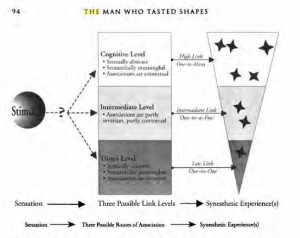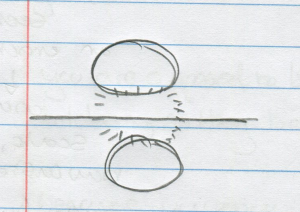Music can alter the perception of a flavor (Kantono et al). This week I have tried to figure out why, and I have started to ask how it can be explored on a personal level. For a week 8 project, I am going to prepare a meal for others in the class, I thought it could be fun to experiment with kinesthetic combinations of flavor and music to conclude my study of Shepherd’s Neurogastronomy: How the Brain Creates Flavor and Why It Matters. Before doing so I had to understand which theory of smelling suited my understanding of the text: the shape theory of smell via the lock and key mechanism or the vibration theory of olfaction via inelastic electron tunneling.
“The taste nerves enter the brainstem, the part of the brain that is directly continuous with the spinal cord and that is responsible for automatic functions such as control of heart rate, breathing, and other vital activities.”
“Reasoning through the gustofacial reflex, I concluded that the mechanism of synesthesia and its link would have to be above the level of the brainstem. (It would presumably not be at this level given that synesthetic responses were idiosyncratic rather than identical as in the gustofacial reflex.) Similarly, evidence gathered so far about language indicated that synesthesia would probably not occur at this highest level of abstract brain processing. The link had to be somewhere in between.” (Cytowic 93)
The following image is from Cytowic’s The Man Who Tasted Shapes. I noticed some similarities in my drawings from the first section of my response to Shepherd’s Neurograstronomy and this depiction.
The line represents the stimulus that can be interpreted at a direct emotional level, the circle below, which might resemble Kahneman and Tversky’s “fast” emotional responsive side of the brain, and the circle above which represents a higher cognitive level of interaction that could represent the brain’s “slow” mode of rational thinking. The intermediate level I discussed in my previous post was only in terms of culture and how it can remove from the ability to be, but here I realize that balancing the interaction between the direct level of interpretation and cognitive levels of interpretation can be attributed to culture, personal ability to develop the emotional capacity of direct levels of understanding, personal ability to develop a sharp mental capacity to understand the interaction between how you want to exist and what emotions are driving your existence – and my favorite – the personal ability to trick yourself into believing you understand any of it.
“An interesting idea. It is the sensation that is memorable, not the name. The name is just semantic baggage attached to it.” (Cytowic 94)
“Luria’s patient S shows this very clearly,” I said. “Despite his prodigious memory, he sometimes made mistakes.Those mistakes were not in reproducing what he was asked to remember incorrectly but in omitting some items from large series. He would use the method of loci, an old memory trick, by placing his synesthetic images throughout an imaginary town and when reading them off as he mentally strolled through it. When he did omit items, his explanation was not that he “forgot” but that he didn’t see them as he walked through his imaginary town.” (Cytowic 94)
This is where I have begun to think about the falsehoods of smell as a lock and key puzzle described with visuals.
“What I am saying is that cross-modal associations are the foundation of language. According to the standard view, language is the highest type of cross-modal association and especially depends on the highest type of cross-modal association and especially depends on the tertiary association cortex and linkages between one part of the cortex and another.” (Cytowic 95)
“What has drawn even more attention to this topic is the fact that extensive music training enhances auditory processing not only within but also beyond this domain, to general and auditory and speech processing. This finding is of great value to our understanding of auditory perception mechanisms and their plastic properties. In particular, it indicates that at least some auditory mechanisms are domain-general in nature, and thus are not special to either music or speech processing. (Asaridou & McQueen)
In my effort to better understand how music and food are interconnected I had to decide which theory of smell best suited my understanding of flavor.
The vibrational theory of olfaction originated in 1928 by Malcolm Dyson and was expanded on by Robert H. Wright in 1954 after it was abandoned in favor of the competing shape theory. Luca Turin revived this theory in 1996 that proposed a different perspective of the mechanism described by Linda Buck and Richard Axel describing the use of the G-protein-coupled receptors in the context of molecular locks and molecular keys to describe unlocking scents. This perspective asked if molecular vibrations using inelastic electron tunneling could be happening (Wikipedia).
In an article from Scientific American, Mark Anderson mentions that odorant molecules usually have hydrogen atoms. In the makeup of these atoms, each very chemically similar to each other, there are different isotopes that strongly affect how a molecule vibrates. A hydrogen nucleus with both a proton and a neutron could be used to better understand the vibration theory because human noses can sniff out the presence of a least some kinds of deuterium (double sized hydrogen with a proton and neutron, rather than just a proton).
“Olfaction is trying to be like an analytical chemist,” Turin says. “It’s trying to identify unknowns.” Chemists identify unknowns using spectrometers. The article mentions how Turin published controversial findings in Nature Neuroscience, and he responded to a negative finding of his experiment in 2004, and explained that it may generate a weak vibrational signal that humans cannot detect. Eric Block, professor of chemistry at the University of Albany, states that Turin can’t have it both ways: they either smell deuterium or they can’t (Anderson 2017).
After hearing about how smell plays a vital part in creating flavor, I wonder if humans can smell deuterium and they can’t because of how it is recorded into memory. This image shows in a very simple way how the process of smelling comes from various signals in the mouth, through my hand sketched-on depiction of the olfactory receptor cells leading into the olfactory bulb, and into the brainstem.
I can’t honestly explain how we perceive smell with anatomy, it confuses the life out of me, but the important takeaway from the diagram is that the tongue, mouth, and all the glands apart of the tasting process send signals to the brainstem while the olfactory receptor cells and olfactory bulb interpret the smell by creating an odor image.
On page 99 of Shepherd’s book on neurogastronomy he asks, “Why is it that the coordinated, multidimensional smell image from the olfactory bulb cannot be sent straight to the highest cortical level – the neocortex – to serve as the basis of perception?… It [the olfactory cortex] represents the transition to the steps of creating the perceptual qualities of smell. It is where the external features of the outside world meet the internal features of our perceptual world.”
A quote from Shepherd on page 119, “There is thus a sharp contrast with the olfactory nerves that enter the front of the brain closest to the highest cognitive centers. It is as if the multisensory flavor sensation is designed to allow ingested foods to be analyzed at both the highest cognitive level as well as at the level of the most vital functions. It has all bets covered.”
So again, can humans smell deuterium and can they not based on how they form the perception of the food and how that perception coexists with the ability to store the odor image as memory?
Shepherd writes about a scientist Haberly who suggested in 1985 that the “olfactory cortex serves as a content-addressable memory for association of odor stimuli with memory traces of previous odor stimuli. He noted the properties necessary for the cortex to function in this manner: a large number of integrative units (pyramidal neurons and synapses) relative to the number of memory traces; a highly distributed, converging-diverging, input (from the olfactory bulb fibers); and positive feedback (the re-excitatory axon collaterals) via highly distributed interconnections between units… Not surprisingly, this basic microcircuit is similar to that in the hippocampus, which is well known for its role in long-term memory. The final property necessary for a cortex to mediate learning and memory consists of the synapses that are reinforced by coincidental action or presynaptic and postsynaptic activity. This is the so-called Hebb rule, named after the psychologist Donald Hebb, who in 1949 suggested that his coincident action would build memory into brain circuits. This too is a property of the synapsis in both olfactory and hippocampal cortices” (Shepherd 101).
The following page describes how the olfactory cortex matches inputs to memory. “The main point is that, whereas the representation of smells in the olfactory bulb is driven by stimulus properties, the representation in the olfactory cortex is memory based.”
Shepherd writes, “This system learns. The basic cortical circuit has the ability to improve its performance with repeated exposure to different smells. The recurrent excitation strengthens the cells activated by input from the olfactory bulb. The lateral inhibition enhances the contrast between activated and less activated cells. Finally, the synaptic strengths change so that the system can store these changes as a memory and match them to the input.”
Shepherd also writes, “The olfactory cortex responds especially to changes in its input signals from the olfactory bulb; it adapts (reduces its responses) to continued stimulation with the same smells.”
This leads me to believe that lateral inhibition was intended as a defense mechanism for humans to smell changes in its environment as a means of detection, which becomes stored as a memory and attached to the input of the smell.
Finally Shepherd states, “These changes with learning enable the system to improve its ability to match an input pattern to a stored pattern, so that finer discrimination between more similar smell molecules can occur. These changes also enable the system to improve its signal-to-noise ratio, so that detection and discrimination of a particular smell can be enhanced against a background of many smells.” (Shepherd 103)
In an article by Tom Brown Jr. on Concentric Rings in nature published in The Tracker magazine in 1984 describes the navigation of stimulation responses when hunting in the woods. Tom Brown Jr. recommends “learning to establish the symphony”, and in the context of the article, is the process of tracking animals in the woods in circular motions as to not create another concentric ring that interferes with the one you are pursuing. For practice, he advises trying to read the concentric circles that are sent off of a particular friend entering the woods after you have sat and established a symphony for a while (Brown 1984).
I don’t think the tracker is able to sit down and triangulate the shape of the animal’s movement through the woods better than the tracker is able to use his nose as a tuning fork, striking a deep breath of fresh air to pick up on resonating frequencies nearby. Over time the tracker’s ability to detect concentric rings increases because of how smell is stored into our memory. The recurrent excitation of smelling with every breath, plus the lateral inhibition of similar smells becoming dulled over time, lead to quicker responses in recognizing changes in the smell environment.



Leave a Reply